Productivity improvement, waste reduction and product quality assurance
In manufacturing, optimising machining processes is crucial for improving productivity, reducing waste and ensuring product quality. In this optimisation effort, science-based tools offer great advantages over classic improvement methods, such as trial and error. In this article, we explore seven benefits of using such science-based tools in machining process optimisation.
In today's fast-paced manufacturing environment, the demand for high-quality, cost-effective and efficient production processes is ever-increasing. The machining process, a critical component of the manufacturing sector, involves removing material from a workpiece to shape it into a desired form. Optimising these machining processes is crucial for improving productivity, reducing waste and ensuring product quality. However, most of these improvements are carried out by trial and error or by experience, which usually takes up a lot of time and resources. On the other hand, science-based tools, grounded in principles of physics, mathematics, and engineering, offer significant advantages in this optimisation effort. Here, we explore seven benefits of using science-based tools in machining process optimisation.
1. Precision and accuracy
Science-based tools enable precise control over machining parameters such as cutting speed, feed rate and depth of cut. By utilising mathematical models and simulations, these tools can predict the behaviour of materials and machining tools under various conditions. This predictive capability allows for fine-tuning of parameters to achieve process stability that assures the highest possible accuracy in the final product, minimising deviations and ensuring tight tolerances. This ensures you have higher chance of getting the process first time right.
2. Enhanced efficiency
One of the primary advantages of using science-based tools is the enhancement of overall machining efficiency. By optimising cutting conditions and tool paths, these tools reduce machining time and improve cycle times. Advanced simulation tools are available today to identify the most efficient sequences of operations, minimising non-productive time and maximising the use of available resources.
3. Cost reduction
Optimising machining processes through science-based tools directly translates to cost savings. Improved efficiency reduces labour costs and machine wear, leading to lower maintenance and replacement expenses. Additionally, by reducing waste and scrap rates through precise control of machining operations, material costs are significantly decreased.
4. Improved tool life
Scientific analysis of machining processes helps in understanding the wear mechanisms of cutting tools. By optimising cutting conditions and employing predictive maintenance strategies, manufacturers can extend the life of their tools. This not only reduces tool replacement costs, but also ensures consistent quality and reduces downtime associated with tool changes.
5. Quality assurance
Science-based tools facilitate the maintenance of high-quality standards in machining processes. Through the use of sensors and real-time monitoring systems, these tools provide continuous feedback on process parameters and part quality. Advanced algorithms can detect anomalies and deviations from the desired specifications, enabling immediate corrective actions and reducing the likelihood of defective products.
6. Sustainability
Optimising machining processes with science-based tools also contributes to environmental sustainability. By improving efficiency and reducing waste, these tools help in minimising the carbon footprint of manufacturing activities. Additionally, the development of eco-friendly machining fluids and the optimisation of energy consumption are facilitated by a scientific approach to process optimisation.
7. Data-driven decision making
The integration of data analytics and machine learning with traditional science-based tools enables data-driven decision-making in machining. By analysing historical data and identifying patterns, manufacturers can make informed decisions about process improvements and optimisations. This approach leads to continuous improvement and adaptability in the face of changing production demands.
Conclusion
The advantages of using science-based tools for optimising machining processes are manifold. From enhanced precision and efficiency to cost reduction and improved tool life, these tools provide a robust framework for achieving superior manufacturing outcomes. As the industry continues to evolve, the integration of scientific principles with advanced technologies will be essential for maintaining competitiveness and driving innovation. Embracing science-based optimisation not only benefits individual manufacturers, but also contributes to the broader goals of sustainability and technological advancement in the manufacturing sector.
Are you interested in using such tools, which are also easy to use and integrate in you production environment? At Sirris we have developed very low-threshold (easy to understand and use by operators) tools that can benefit you from the first instance. Get in touch with us, to explore such opportunities together! |




